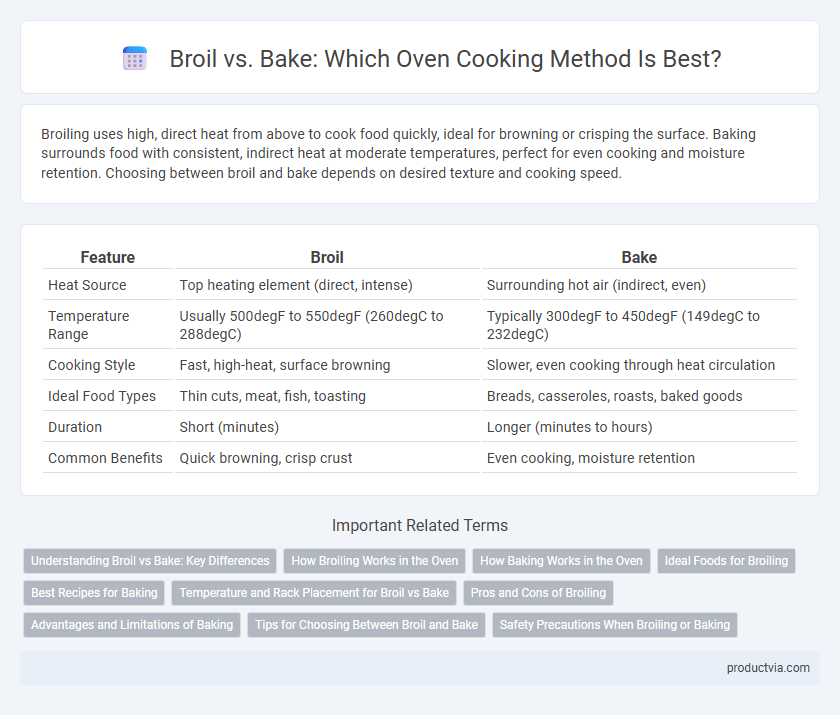Broiling uses high, direct heat from above to cook food quickly, ideal for browning or crisping the surface. Baking surrounds food with consistent, indirect heat at moderate temperatures, perfect for even cooking and moisture retention. Choosing between broil and bake depends on desired texture and cooking speed.
Table of Comparison
| Feature | Broil | Bake |
|---|---|---|
| Heat Source | Top heating element (direct, intense) | Surrounding hot air (indirect, even) |
| Temperature Range | Usually 500degF to 550degF (260degC to 288degC) | Typically 300degF to 450degF (149degC to 232degC) |
| Cooking Style | Fast, high-heat, surface browning | Slower, even cooking through heat circulation |
| Ideal Food Types | Thin cuts, meat, fish, toasting | Breads, casseroles, roasts, baked goods |
| Duration | Short (minutes) | Longer (minutes to hours) |
| Common Benefits | Quick browning, crisp crust | Even cooking, moisture retention |
Understanding Broil vs Bake: Key Differences
Broil uses intense, direct heat from above to quickly cook and brown food, making it ideal for finishing dishes or crisping surfaces. Bake employs consistent, indirect heat circulated throughout the oven, perfect for even cooking of breads, casseroles, and desserts. Understanding these key differences enhances cooking precision and optimizes texture and flavor outcomes.
How Broiling Works in the Oven
Broiling in the oven involves exposing food to direct, intense heat from the top heating element, which rapidly cooks and browns the surface. This high-temperature method is ideal for searing meats, melting cheese, and achieving a crispy exterior. Unlike baking, which uses ambient heat to cook food evenly throughout, broiling targets the food's surface for quick caramelization and texture enhancement.
How Baking Works in the Oven
Baking in an oven relies on surrounding hot air to cook food evenly through convection, typically set between 325degF and 375degF, which allows heat to penetrate the surface and gradually cook the interior. The oven's consistent temperature facilitates Maillard browning and caramelization, enhancing flavor and texture in baked goods and casseroles. Unlike broiling, which uses direct high heat from above, baking ensures thorough and uniform cooking with gentle heat circulation.
Ideal Foods for Broiling
Broiling is ideal for cooking tender, thin cuts of meat such as steaks, chops, and fish fillets, as it applies high, direct heat that quickly sears the surface while preserving juices. Vegetables like asparagus, peppers, and zucchini also respond well to broiling, developing a charred exterior and enhanced flavor without becoming soggy. Broiling is perfect for dishes requiring a crispy top, including melting cheese on casseroles or toasting breadcrumbs.
Best Recipes for Baking
Baking utilizes consistent, indirect heat, making it ideal for recipes like cakes, bread, and casseroles that require even cooking and moisture retention. Broiling applies intense, direct heat from above, perfect for quickly melting cheese or crisping the surface of dishes such as gratins and open-faced sandwiches. For best baking results, recipes that benefit from gentle, uniform heat, such as pastries, cookies, and slow-cooked roasts, should be prioritized.
Temperature and Rack Placement for Broil vs Bake
Broil cooking uses high, direct heat typically at temperatures around 500degF to 550degF, with the oven rack placed near the top element to quickly brown or char food surfaces. Bake cooking employs moderate, indirect heat usually between 325degF and 450degF, with the rack positioned in the middle to ensure even heat distribution for thorough cooking. Proper rack placement is crucial; broiling requires close proximity to the heating element while baking benefits from central placement for balanced heat exposure.
Pros and Cons of Broiling
Broiling uses intense direct heat from above, allowing for rapid cooking and caramelization, which enhances flavor and creates a crispy exterior ideal for meats and vegetables. It conserves time compared to baking but requires close monitoring to prevent burning or uneven cooking due to high temperature exposure. Broiling is less suitable for large or dense dishes that need even, slower heat penetration, where baking remains superior.
Advantages and Limitations of Baking
Baking offers even heat distribution through convection, making it ideal for cooking foods like bread, cakes, and casseroles with consistent texture and moisture retention. Its advantage lies in the ability to cook food thoroughly without direct exposure to high heat, preserving flavor and preventing charring. Limitations include longer cooking times compared to broiling and less effective browning on the surface, which may result in less crispiness for certain dishes.
Tips for Choosing Between Broil and Bake
Broil is ideal for quick, high-heat cooking, perfect for browning or melting toppings, while bake uses consistent, moderate heat suitable for thorough cooking of cakes, casseroles, and bread. Choose broil when you want a crispy, caramelized surface and bake for even cooking through the interior of food. Consider food thickness and desired texture to decide between the intense direct heat of broiling and the gentle, surrounding heat of baking.
Safety Precautions When Broiling or Baking
When using an oven to broil or bake, ensure the oven rack is positioned correctly to prevent food from burning or uneven cooking. Broiling requires close monitoring due to high direct heat, making it essential to use oven mitts and avoid placing flammable materials nearby. For baking, maintain a clean oven interior and avoid overcrowding to ensure proper air circulation and reduce the risk of fire hazards.
Broil vs Bake for cooking method Infographic

 productvia.com
productvia.com